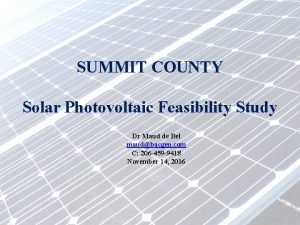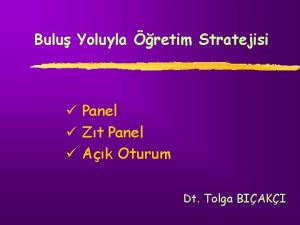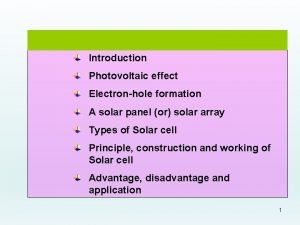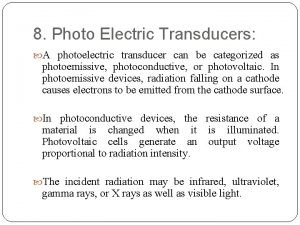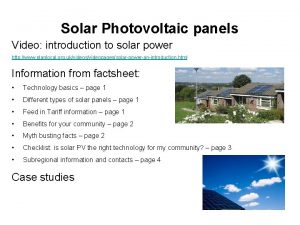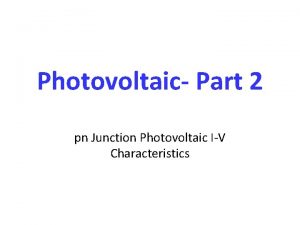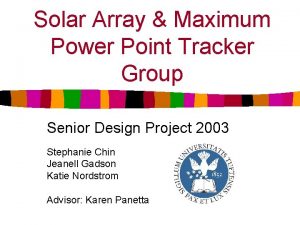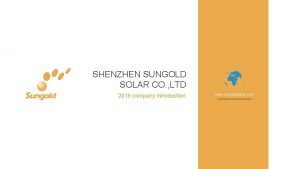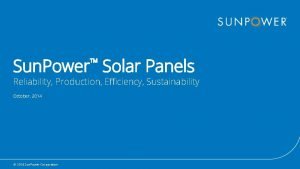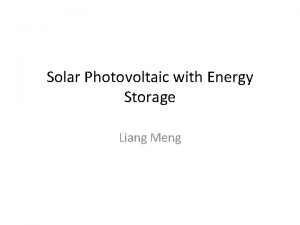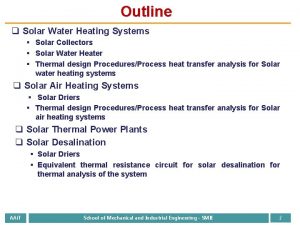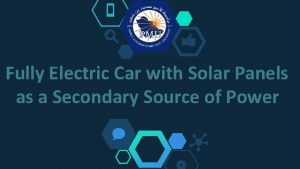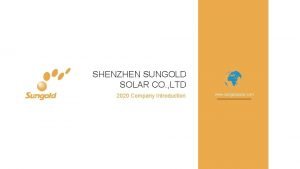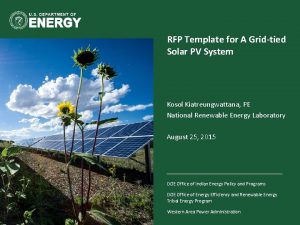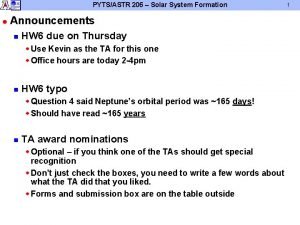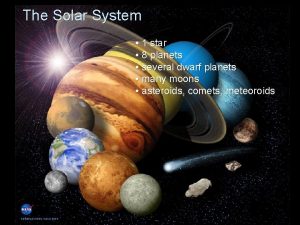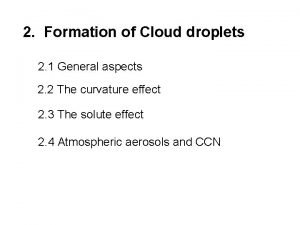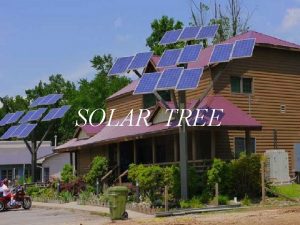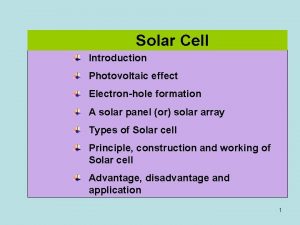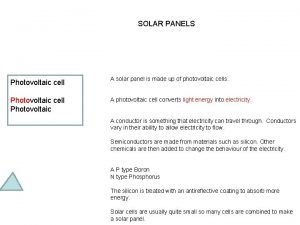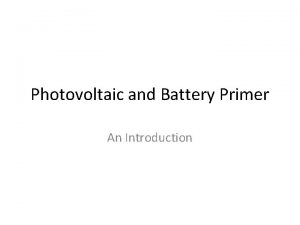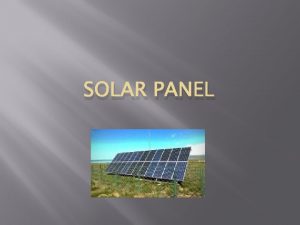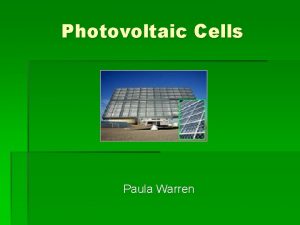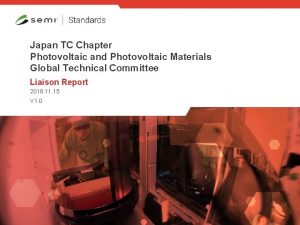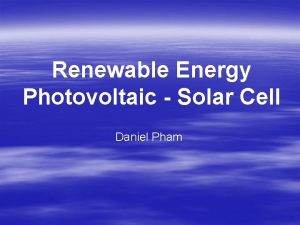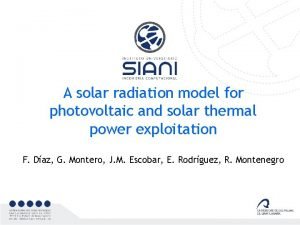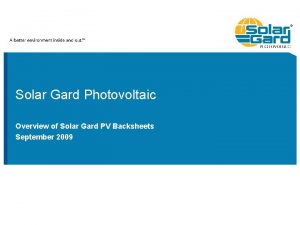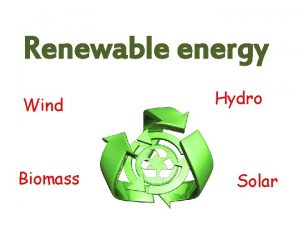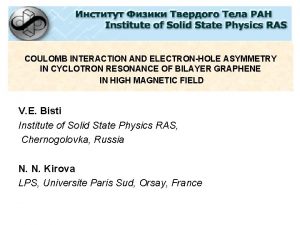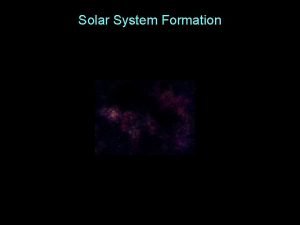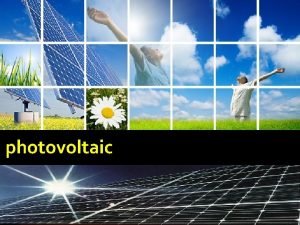Introduction Photovoltaic effect Electronhole formation A solar panel
































- Slides: 32

Introduction Photovoltaic effect Electron-hole formation A solar panel (or) solar array Types of Solar cell Principle, construction and working of Solar cell Advantage, disadvantage and application 1

1. Introduction Recap (Lecture-1) : Photo means light in Greek and Volt is the name of a pioneer in the study of electricity Alessandro Volta Albert Einstein was awarded the 1921 Nobel Prize in physics for his research on the photoelectric effect—a phenomenon central to the generation of electricity through solar cells. In the early stages, the solar cell was developed only with 4 to 6 % efficiency( because of inadequate materials and problems in focusing the solar radiations). But, after 1989, the solar cells with more than 50% efficiency was developed. 2

Second Generation Second generation materials have been developed to address energy requirements and production costs of solar cells. Alternative manufacturing techniques such as vapour deposition and electroplating are advantageous as they reduce high temperature processing significantly 3

Materials for Solar cells are composed of various semiconducting materials 1. 2. 3. 4. 5. 6. Crystalline silicon Cadmium telluride Copper indium diselenide Gallium arsenide Indium phosphide Zinc sulphide Note: Semiconductors are materials, which become electrically conductive when supplied with light or heat, but which operate as insulators at low temperatures 4


• If two differently contaminated semiconductor layers are combined, then a so-called p-n-junction results on the boundary of the layers. p-n junction layer n-type semiconductor p- type semiconductor • By doping trivalent element, we get p-type semiconductor. (with excess amount of hole) • By doping pentavalent element, we get semiconductor ( with excess amount of electron) n-type 6

2. Photovoltaic effect Definition: The generation of voltage across the PN junction in a semiconductor due to the absorption of light radiation is called photovoltaic effect. The Devices based on this effect is called photovoltaic device. Light energy n-type semiconductor p- type semiconductor Electrical Power p-n junction 7

3. electron-hole formation • of photons strikes on the earth. (photon is a flux of light particles) • On a clear day, about 4. 4 x 1017 photons strike a square centimeter of the Earth's surface every second. • excess of the band gap - can be converted into electricity by the solar cell. • be absorbed and promote an electron from the valence band to the conduction band. 8

Conduction band electron Photons hole Valence band • called hole. • valence band combine together and forms electron-hole pairs. 9

4. A solar panel (or) Solar array Single solar cell • sandwiched with p-type layer. • large-area p-n junction made from silicon wafer. • A single cell can produce only very tiny amounts of electricity • calculator. • appliances such as watches and calculators 10

Single Solar cell N-type P-type 11

Solar panel (or) solar array (or) Solar module The solar panel (or) solar array is the interconnection of number of solar module to get efficient power. • solar cells. • glass plate to protect from the bad whether. • can be produced. 12

13

5. Types of Solar cell Based on the types of crystal used, soar cells can be classified as, 1. Monocrystalline silicon cells 2. Polycrystalline silicon cells 3. Amorphous silicon cells 1. The Monocrystalline silicon cell is produced from pure silicon (single crystal). Since the Monocrystalline silicon is pure and defect free, the efficiency of cell will be higher. 2. In polycrystalline solar cell, liquid silicon is used as raw material and polycrystalline silicon was obtained followed by solidification process. The materials contain various crystalline sizes. Hence, the efficiency of this type of cell is less than Monocrystalline cell. 14

3. Amorphous silicon was obtained by depositing silicon film on the substrate like glass plate. • The layer thickness amounts to less than 1µm – the thickness of a human hair for comparison is 50 -100 µm. • The efficiency of amorphous cells is much lower than that of the other two cell types. • As a result, they are used mainly in low power calculators, pocket equipment, watches andassuch or as facade elements. 15

Comparison of Types of solar cell Material Efficiency (%) Monocrystalline silicon 14 -17 Polycrystalline silicon 13 -15 Amorphous silicon 5 -7 16

6. Principle, construction and working of Solar cell Principle: of photovoltaic effect. The photovoltaic effect is the photogeneration of charge carriers in a light absorbing materials as a result of absorption of light radiation. Construction • semiconductor (emitter) layer and p-type semiconductor layer (base). The two layers are sandwiched and hence there is formation of p-n junction. • The surface is coated withanti-refection coating to avoidthe loss of incident light energy due to reflection. 17

18

19

• type side of the semiconductor for electrical connection Working: When • solar apanel exposed sunlight tothe light energies , are absorbed by a semiconduction materials. • and produce the external DC current. The • DC current converted is into 240 -volt AC current using an inverter for different applications. 20

Mechanism: • panel. • increase in energy. At the same time making them free to move around in the material. • only a short time before returning to their original lower energy position. • energy gained from the light, a PN junction is typically used. 21

• A PN junction consists of two different regions of a semiconductor material (usually silicon), with one side called the p type region and the other the n-type region. • During the incident of light energy, in p-type material, electrons can gain energy and move into the n-type region. • Then they can no longer go back to their original low energy position and remain at a higher energy. • The process of moving a light- generated carrier from p-type region to n-type region is called collection. • These collections of carriers (electrons) can be either extracted from the device to give a current, or it can remain in the device and gives rise to a voltage. 22

• up their energy to whatever is connected to the solar cell, and then re-enter the solar cell. Once back in the solar cell, the process begins again: 23

The mechanism of electricity production- Different stages Conduction band High density Valence band Low density E The above diagram shows the formation of p-n junction in a solar cell. The valence band is a low-density band conduction band is high-density band. 24

Stage-1 When light falls on the semiconductor surface, the electron from valence band promoted to conduction band. Therefore, the hole (vacancy position left by the electron in the valence band) is generates. Hence, there is a formation of electron-hole pair on the sides of p-n junction. Conduction band High density E Valence band Low density 25

Stage-2 In the stage 2, the electron and holes are diffuse across the p -n junction and there is a formation of electron-hole pair. Conduction band High density junction E Valence band Low density 26

Stage-3 In the stage 3, As electron continuous to diffuse, the negative charge build on emitter side and positive charge build on the base side. Conduction band High density junction E Valence band Low density 27

Stage-4 When the PN junction is connected with external circuit, the current flows. Conduction band High density junction E Valence band Low density Power 28

7. Advantage, disadvantage and application of Solar cell Advantage 1. It is clean and non-polluting 2. It is a renewable energy 3. 4. 5. Solar cells do not produce noise and they are totally silent. They require very little maintenance They are long lasting sources of energy which can be 6. 7. used almost anywhere They have long life time There are no fuel costs or fuel supply problems 29

Disadvantage 1. Solar power cannot be obtained in night time 2. Solar cells (or) solar panels are very expensive 3. Energy has to be stored in batteries 4. Air pollution and whether can affect the production of electricity 5. They need large are of land to produce more efficient power supply 30

Applications 1. Soar pumps are used for water supply. 1. Domestic power supply for appliances include refrigeration, washing machine, television and lighting 1. Ocean navigation aids: Number of lighthouses and most buoys are powered by solar cells 1. Telecommunication systems: radio transceivers on mountain tops, or telephone boxes in the country can often be solar powered 1. Electric power generation in space: To providing electrical power to satellites in an orbit around the Earth 31

32
 Wholesalesolar.com/solar panels
Wholesalesolar.com/solar panels Solar installation summit county
Solar installation summit county Continuous panel vs discontinuous panel
Continuous panel vs discontinuous panel Zıt panel
Zıt panel Photovoltaic effects
Photovoltaic effects In photo emissive transducers, electrons are attracted by
In photo emissive transducers, electrons are attracted by Photovoltaic video
Photovoltaic video Photovoltaic
Photovoltaic Photovoltaic array maximum power point tracking array
Photovoltaic array maximum power point tracking array Sungold solar
Sungold solar Sunpower solar panel sustainability
Sunpower solar panel sustainability Thermolite solar charging system
Thermolite solar charging system New york energy storage
New york energy storage Solar panel heat exchanger
Solar panel heat exchanger Orex solar panel
Orex solar panel Sungold solar panel
Sungold solar panel Kosol solar panel review
Kosol solar panel review What is an inexhaustible source of energy
What is an inexhaustible source of energy Formation of the solar system comic strip
Formation of the solar system comic strip Formation of the solar system
Formation of the solar system As the solar nebula contracts, it
As the solar nebula contracts, it The formation of the solar system
The formation of the solar system Formation initiale vs formation continue
Formation initiale vs formation continue Curvature effect in cloud formation
Curvature effect in cloud formation Curvature effect in cloud formation
Curvature effect in cloud formation Encourage pedestrian embarrassed
Encourage pedestrian embarrassed Chloride shift
Chloride shift Founder effect vs bottleneck effect
Founder effect vs bottleneck effect Slutsky equation
Slutsky equation Conclusion of solar tree
Conclusion of solar tree Function of nephron slideshare
Function of nephron slideshare Slidetodoc.com
Slidetodoc.com Cause and effect conclusion
Cause and effect conclusion

